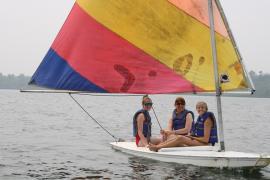Standing in a crowded room (pre-COVID-19) with your best smile on, you hope that something on your table will catch the eye of at least one of the sharply dressed college students cruising your aisle. Even if just long enough for you to begin your pitch, “Got plans for the summer?” They keep walking. All day, they just keep walking. A thought creeps in, “This was a waste of time!” The trip, the registration cost, the hotel, and perhaps most importantly, one of the fleeting spring days left until summer, all wasted.
To be fair, not all career expos feel this way, but often I have felt like David in a room full of Goliaths. How can we expect to compete with major employers like Apple, Nike, or General Motors? I once stood next to the FBI at a three-hour fair. The only two candidates I talked to all day stepped out of line with the Bureau just long enough to tell me they liked my stickers and to ask for one. On my way out, I snagged an FBI koozie for my collection and thought, “There has to be a better way.” I believe there is!
What if your recruitment efforts started at your camp — with campers you already know? The following is a brief description of how we plan to flip our recruitment strategy from outside to the inside. There are a couple things that you should know about this plan, and they are things that we are still adjusting to at Falling Creek. First, this is not a quick fix for your staffing needs. To do this the right way takes time — like years. Secondly, this will not eliminate your need to recruit outside of your current network. Your camp, just like ours, will always need new staff. Over time though, this plan may help cut down on the resources you allocate to recruiting, while simultaneously adding a layer of depth to the programming, culture, and tradition at your camp.
We took a deep look at our staff statistics and something became clear. We found that the lion’s share of our best staff year to year were former campers. They knew the program, they knew the culture, and they had a passion for passing along the magic of camp. We decided to start here. We considered how we could do a better job at helping campers transition into counselors.
The interesting thing was that we had never really marketed directly to this group before, so those who found their way home, so to speak, did so on their own. Then it clicked — we didn’t need to travel the entire southeast each spring to find what we needed. It was right in front of us each summer. So what now?
Our first challenge was finding out how to reconnect with former campers. As campers, all of our communication would have been with their parents, so we started there. We created a campaign called “It’s Your Time,” basically begging parents to forward our letters and emails to their college-aged students. The message was simple: “Now it's your time to return to camp and make an impact, the way your favorite counselor did for you.” We planned these campaigns to land at the times students would be home for extended breaks from school, like Thanksgiving and Christmas. Responses were mixed. Some families obliged, but many felt like their son’s time at camp had come and gone. This gained us a handful of contacts and even fewer applications, but a few felt better than nothing. We had a start.
We later would create an annual spring social media campaign targeted at high school seniors who had ever spent a summer at camp. If they would complete a simple Google form providing their intended college or next step and their contact information, we would mail them an exclusive “Young Alumni” pin. Respondents were encouraged to wear their new pins on graduation day a couple months later, and to share a picture with us on social media. Now we were capturing their contact info, what college they were headed to for recruitment travel planning, and they were basically generating social media posts for us. More momentum!
Our program at the time included a “gap year” for campers, meaning they had to take a summer off between their last year as a camper and their first year as a cabin counselor. This meant that we lost touch with our most tenured campers for two years before they were ready to make their return as a counselor. Bummer. Instead, we decided to create a program that eliminated the gap year and allowed for a return to camp during the summer after their senior year by working in various support positions: i.e., grounds maintenance team or in the kitchen.
This program was initially called “DASH”, as it represented the dash between their time as campers and counselors. This program allowed them to remain engaged with the camp community, but they lived in their own cabin as a group without campers. Most importantly, we were able to pour into them for another summer as they prepared for life after high school. We quickly realized we were on to something.
We were certainly gaining ground, but we still felt like we were trying to catch up with a speeding train that had already passed. We needed to get out in front. We needed something new.
Every camp has traditions. Falling Creek is no exception. We wear white T-shirts on Sundays. We say specific blessings for every meal. We have a “Beaver-Shark” in our lake (wink wink). In perhaps our most ambitious undertaking yet, we decided to create a new tradition. Not exactly create it — rather to add some intentional language around it. The power of jargon at camps cannot be underestimated, so we coined a catchphrase. Five years ago I casually referred to our indoor soccer court as the “Thunder-Dungeon” into a microphone, and guess what it’s still called today?
Our new phrase is so simple it’s scary. We began referring to the act of a former camper returning to be on staff as the “Greatest Tradition of All!” Since our founding the “Spirit of Falling Creek” has always been equated to the idea of unselfishness. By tapping into the same sentiment, we were able to find something new to sink our teeth into. We threw our new phrase into conversation every chance we could with staff and campers, especially our older campers.
A token of recognition was created for those who had returned, and this year a ceremony will be held around its presentation. We needed to make the optics of coming back on staff as exciting as possible.
The narrative of the journey is one that we have strongly embraced at Falling Creek, as it allows us to create conversation with campers and staff about moving through life and all that comes with it. We began to discuss the journey of camp in halves. We now refer to campership as just half of the journey. In this way we can stress the significance of returning as staff. No matter how many summers you may have been a camper, there’s still more to do. There is still room to grow and there is still more to give.
The last event of each summer is the “Ceremony of Light,” our traditional closing campfire that marks the end of a camper’s time. What would normally be regarded as the last night a camper may ever spend on the mountain, will this year be framed as a ceremony of transition. “The sun will rise tomorrow and your journey at camp will be anew, not over.” Instead of saying tearful goodbyes, we will fill them with encouragements that will leave no doubt in our anticipation of their return as staff. The time when they will bring their light back to this place to share with the next generation as they complete the “Greatest Tradition of All” at Falling Creek.
We always knew the toughest case to crack would be with our parents. We recognize that the ultimate measure of success for this recruitment strategy will come when we have buy-in from parents. It is no surprise to any of you that parents are more involved than ever in the decision-making processes of campers, and college students. We want them to see the value in their young adult returning to camp during the increasingly cluttered and limited college summers.
We want them to understand that our ability to support the growth of their child is just as valuable in young adulthood as it was in adolescence. As with our campers, the first stage has been developing language and understanding with our parents. To bring it full circle to our career fair experience, we see our parents as the stubborn career advisor that refuses to see a summer at camp as a comparable experience to sitting in a cubicle someplace completing an “internship.” We know it will take time, and we may not be there yet, but we know that it is working!
I know that some of these strategies may not fit the model of your camp, but I hope that by sharing our story, you are inspired to consider the value in creating a culture of recruiting amongst your campers and their families. Good luck getting your staff team together this spring, and may you have a safe and successful summer in 2021!
This blog was written on behalf of Project Real Job’s efforts to help camps recruit, hire, and retain staff.
Kyle Jeffries has been the program director at Falling Creek for the past five years. He holds an MSSW from the University of Tennessee and has been working in youth development for over a decade. Kyle can be reached at [email protected].
Photo courtesy of Cranbook Schools Summer Camps in Blooming Hills, Michigan
The views and opinions expressed by contributors are their own and do not necessarily reflect the views of the American Camp Association or ACA employees.



